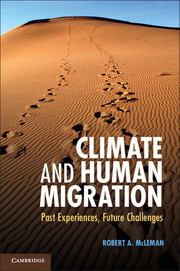Book contents
- Frontmatter
- Dedication
- Contents
- List of Figures
- List of Tables
- Preface
- Acknowledgments
- 1 An Introduction to the Study of Climate and Migration
- 2 Why People Migrate
- 3 Migration in the Context of Vulnerability and Adaptation to Climatic Variability and Change
- 4 Extreme Weather Events and Migration
- 5 River Valley Flooding and Migration
- 6 Drought and Its Influence on Migration
- 7 Mean Sea Level Rise and Its Implications for Migration and Migration Policy
- 8 Emergent Issues in Climate and Migration Research
- Annex Estimates of Global Population Exposed to Tropical Cyclones
- References
- Index
Preface
Published online by Cambridge University Press: 05 December 2013
- Frontmatter
- Dedication
- Contents
- List of Figures
- List of Tables
- Preface
- Acknowledgments
- 1 An Introduction to the Study of Climate and Migration
- 2 Why People Migrate
- 3 Migration in the Context of Vulnerability and Adaptation to Climatic Variability and Change
- 4 Extreme Weather Events and Migration
- 5 River Valley Flooding and Migration
- 6 Drought and Its Influence on Migration
- 7 Mean Sea Level Rise and Its Implications for Migration and Migration Policy
- 8 Emergent Issues in Climate and Migration Research
- Annex Estimates of Global Population Exposed to Tropical Cyclones
- References
- Index
Summary
Preface
Over the past decade or so various sources have produced reports and studies warning that climate change and sea level rise will cause hundreds of millions of people to become environmental refugees in coming decades. One prediction issued in 2005 estimated that by the year 2010 climate change would create 50 million environmental refugees worldwide (thankfully, that prediction proved wrong). Just the same, these concerns have prompted scholars, refugee advocates, and international organizations to call for new policies and laws to protect those whom climate change might displace. National intelligence agencies have commissioned studies of the security implications of climate change–induced displacement, and on two occasions the United Nations (UN) Security Council has held discussions on what ought to be done. UN Environment Programme officials have reported that the Darfur conflict was in part caused by climate change, while the popular media has identified groups living on the Alaskan coast, on Micronesian atolls, and in Africa’s Lake Chad region as the world’s first ‘climate change refugees’. In short, it has become widely accepted that climate change–driven migration will have a significant impact on our future well-being, and for some people it may already be doing so.
I agree that the risks posed by anthropogenic climate change do indeed have the potential to cause large-scale population displacements in many countries. Extreme climate events already do so, as we have seen in recent years through examples like Hurricane Katrina and severe droughts in East Africa. However, the environmental refugee scenario (or more precisely, ‘climate change refugee’ scenario) is only one of the many ways climate affects migration patterns and behavior, most of which do not make the headlines and do not enter into public discussions about climate change. These include a wide range of diverse examples, a sample of which include: drought-induced changes in marriage-related migration in Ethiopia; influxes of temporary labor migrants to Bangladesh’s cities during monsoonal floods; changing pastoralist movements in West Africa; and the ongoing flow of financially secure retirees from the northeastern United States to the Sun Belt. None of these are refugee scenarios. To varying degrees, the migrant in each of these examples exercises some degree of discretion and control over the duration and destination of migration and, indeed, over the decision of whether to migrate in the first place.
- Type
- Chapter
- Information
- Climate and Human MigrationPast Experiences, Future Challenges, pp. xi - xviPublisher: Cambridge University PressPrint publication year: 2013



